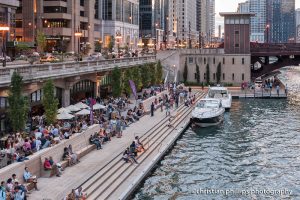Alfred Benesch & Company was an Award Winner for its Chicago Riverwalk project in the 2017 Annual Excellence in Structural Engineering Awards Program in the Category – Other Structures.
For over 20 years, the City of Chicago had planned to enhance the main branch of the Chicago River by creating a continuous Riverwalk connecting the Lakefront to Chicago’s West Loop. Although the area has been referred to as the Riverwalk for many years, the path was interrupted by each crossing street and was only accessible via stairs at the ends of each block. The site was relatively featureless, with a concrete walking surface approximately seven feet above the water and only a few park benches, providing very little attraction to a very valuable piece of land along the river. During the reconstruction of the adjacent Wacker Drive Viaduct in the early 2000s, the roadway and structure were configured for future expansion. Sometime after, a renewed vision by the City aimed to develop the Riverwalk as Chicago’s “second shoreline” – a premier public space that would enable the city’s residents, workers, and visitors to connect with nature and the many recreational amenities offered by the urban waterway.
Designing and constructing the Riverwalk required extensive mitigation of existing structures below and above the water’s surface. To protect the many adjacent subsurface utilities, sewer outfalls, chiller pipes, freight tunnels, and the Chicago Transit Authority subway tunnels, extensive and sophisticated structure modeling was required to understand and monitor potential impacts to the existing infrastructure.
Above the water, creating the much-needed connections between the existing Riverwalk sections while preserving the integrity of the river’s historic bascule bridges was both an engineering and aesthetic challenge. The project team’s unique solution: canopied piers, or underbridges, were designed to create a new, continuous path along the six-block Riverwalk, which could resist substantial vessel collision loading and had minimal impact to existing historic structures. This critical design was achieved using drilled shafts that extended to the hardpan layer about 70 feet below the water’s surface. The structural framework was completed using an ingenious “bathtub” approach in which precast materials were delivered via barge and installed over the top of the drilled shafts. Concrete was then placed into the precast form to complete each underbridge. This method minimized construction duration, cost, and disturbance in the river by eliminating the need for underwater formwork.
The interior shafts at each underbridge are located beneath the bascule bridges and required bridge lifts for installation. Test lifts were performed during the design phase of the project to determine the maximum opening angle that could be achieved. Existing plans were then used to develop clearance diagrams to aid the Contractor during the bid phase. Temporary closures of approximately one week were used at each street for installation.
Early Value Planning studies considered numerous alternatives for designing and constructing each of the six new “rooms” spanning the Riverwalk, ranging from pile-supported piers to floating docks. The desired and ultimately chosen design favored conventional tied back sheet pile walls to tie back to the existing wall where a concrete anchor block was cast over the wale, and timber piles stabilizing the new system, using existing tie rods. By incorporating the existing system in the final design, the number of new materials required and the carbon footprint were significantly reduced.
Previous construction of other Riverwalk segments revealed that the tie rods were in excellent condition with minimal corrosion when the concrete encasement was removed. While there were not many concerns over the condition of the existing materials, consideration was still given to the redundancy of the system. In the event of an existing tie rod failure, the concrete anchor block and structural slab were designed and detailed with enough strength to redistribute the load to the adjacent tie rods. The structural slab is also able to transfer loads out to the peninsulas at each end of the rooms where additional lateral resistance can be developed. This cost-effective solution made practical use of rehabilitating existing materials, reducing cost and construction time.
Because the Chicago River is navigable, a channel opening of 95 feet had to be maintained for boat traffic at all times during construction. Material deliveries were carefully maneuvered to the construction site by barges, and the majority of the work was completed off multiple barges adjacent to the dock wall at each section of the Riverwalk. The contractor also had to consider the river’s ability to rise considerably following heavy rainfall. They implemented an overnight staging plan placing barges away from the historic bascule bridges so that, if waters were to rise, the bridges would not be damaged by construction equipment.
2,800 feet of new continuous walkway has transformed Chicago’s 1.3-mile Chicago Riverwalk, connecting the Lakefront to Chicago’s West Loop. The project’s six uniquely designed sections successfully integrated the original Riverwalk walls and utilized innovative precast underbridges supported on drilled shafts passing beneath each of the Chicago River’s historic bascule bridges. Now complete and open to the public, the Riverwalk not only enhances the environment but enables residents, workers, and visitors to connect with the many recreational, cultural, and economic amenities offered by the Chicago River.▪

